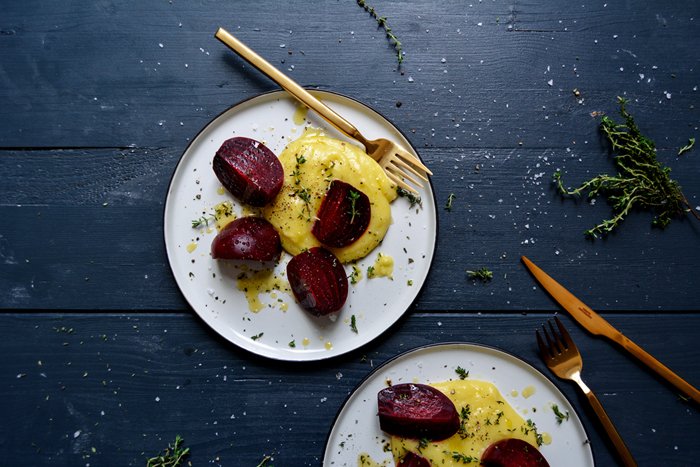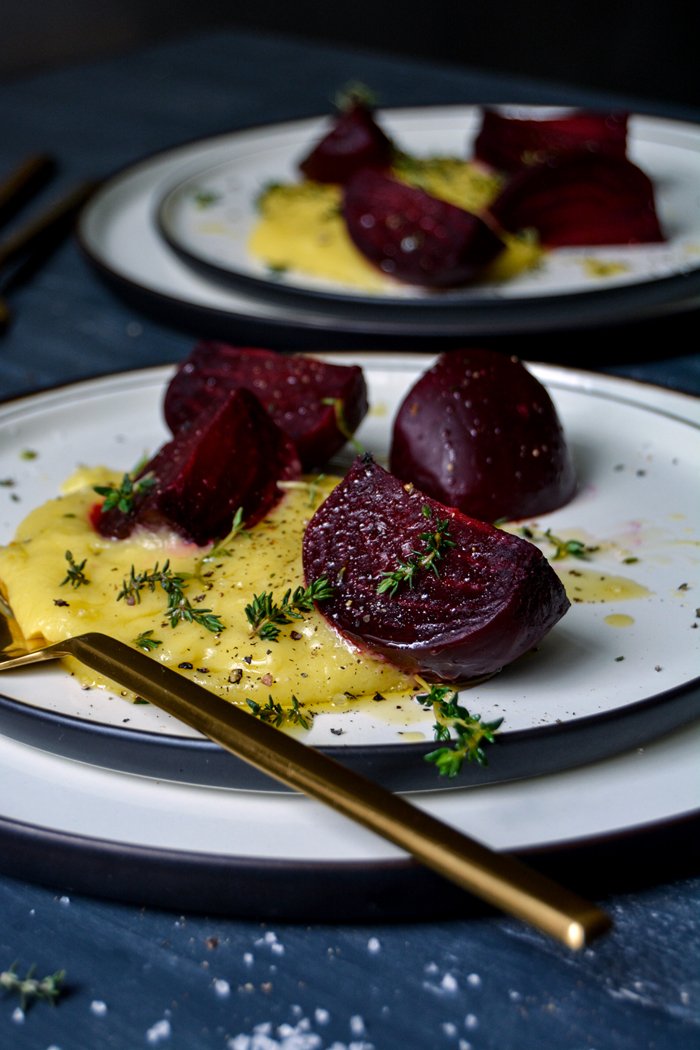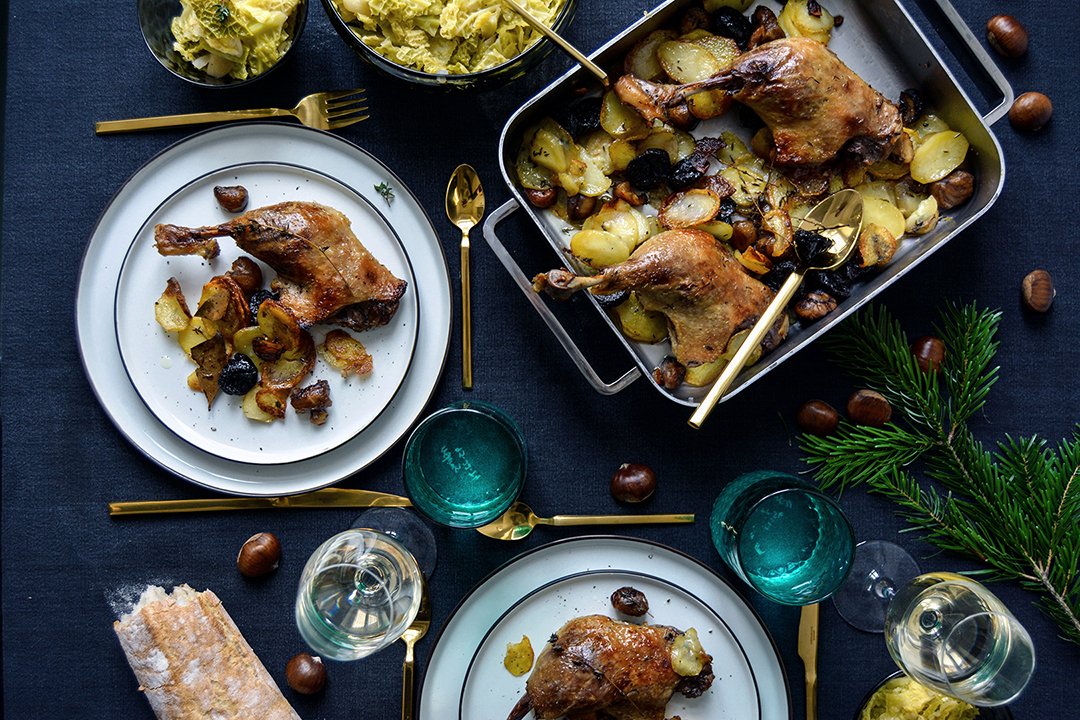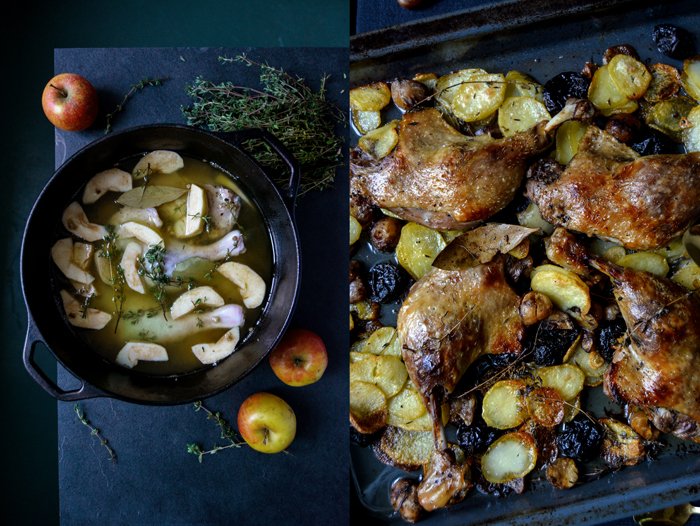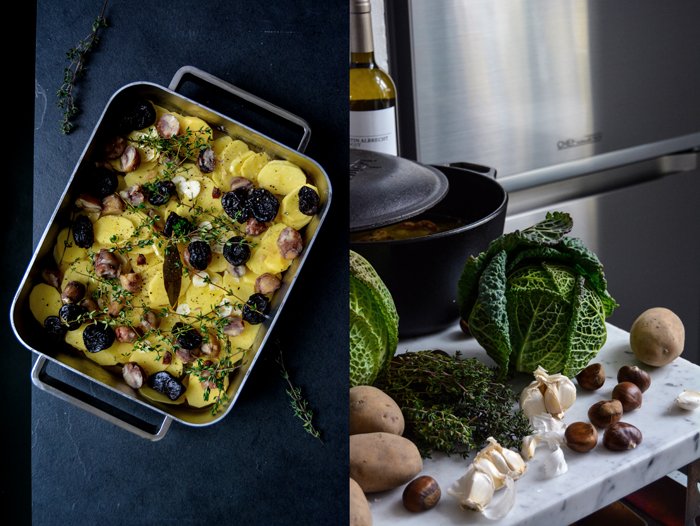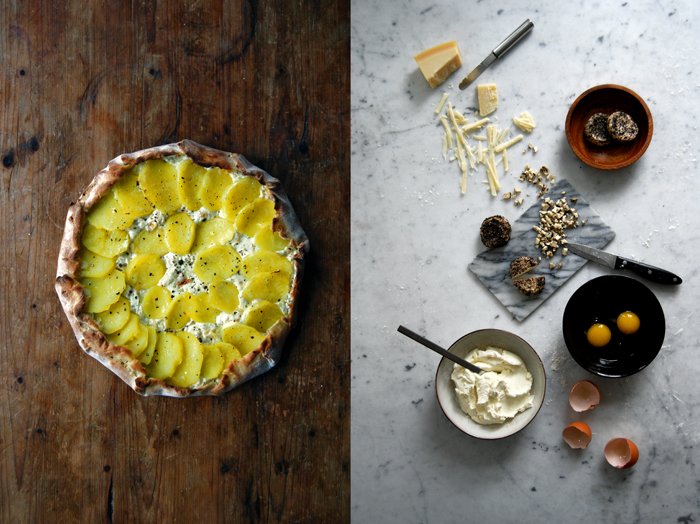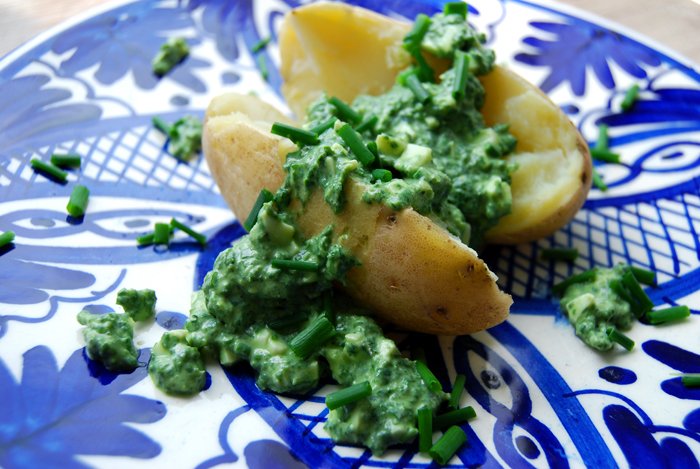Potatoes with Cinnamon Hummus, Basil, and Prawns
When I have a bowl of hummus in front of me, I grab the biggest spoon I can find and enjoy this creamy, nutty deliciousness with inexplicable enthusiasm. I don't know where this fascination comes from, I only discovered this Middle Eastern dip relatively late in my kitchen, but I'm obsessed with it.
Most of the time I'm not even very experimental, I just stick to my basic recipe, but sometimes my mood calls for a little change. I either replace the chickpeas with white beans, stir in some fresh or dried herbs, or I try less pleasant combinations that I never ever want to taste again (like my avocado hummus - disastrous!). There must be something in the tahini - the rich, oily sesame sauce that's used for hummus - its nutritional value, that my body is almost addicted to. I can eat the thick, pure sauce by the spoon, straight out of the jar. It's strange.
One of my latest experiments led to a very simple yet absolutely scrumptious result: a generous amount of ground cinnamon and a pinch of ground cumin. The spices enhance the dip's sweetness and give it a warm and earthy touch. You don't actually taste them, they merge with the other ingredients and create a new flavour, which makes me want to eat even more of it. To accomplish the sweet side of the hummus, I added sliced boiled potatoes (warm or cold, both work), fresh basil, and a few prawns. It felt like summer on a plate and reminded me of a similar Mediterranean meal we had in Malta last year.
Potatoes with Cinnamon Hummus, Basil, and Prawns
Serves 4
For the hummus
drained and rinsed canned chickpeas, 240g / 8 ounces
tahini 150g / 5 ounces
water 120ml / 1/2 cup
freshly squeezed lemon juice 4 tablespoons
garlic, crushed, 1 large clove
ground cinnamon 1/4 teaspoon
ground cumin 1/8 teaspoon
fine sea salt about 1 teaspoon
For serving
olive oil
prawns, the heads cut off, 8-12
boiled potatoes (warm or cold) 8-12
flaky sea salt
black peppercorns, crushed in a mortar
fresh basil leaves, a small handful
For the hummus, purée the ingredients in a blender and season with cinnamon, cumin, and salt to taste.
In a large pan, heat a splash of olive oil over high heat and sear the prawns for 1-2 minutes per side or until cooked through.
Arrange the sliced potatoes on 1 large platter or on 4 small plates, drizzle generously with the hummus and additional olive oil, and season to taste with flaky sea salt, crushed pepper, cumin and cinnamon. Place the prawns on top, sprinkle with basil and enjoy immediately.
Beetroot and Skordalia - a velvety Greek Garlic Potato Dip
If you feel like garlicky mayonnaise but you're pushed away by its oily heaviness, cook some garlic and potatoes, then throw them in a blender, and you'll end up with skordalia. This popular Greek dip has a similar smooth texture if you pulse it - it becomes thick, sticky, and starchy. The added olive oil adds a Mediterranean touch and taste to it and makes it feel like velvet. If you use a potato masher, which is more common, it will be more chunky, like mashed potatoes, so it really depends on what kind of dip you're after. I was in a mayonnaise kind of mood so the blender was my tool of choice.
Skordalia is a new discovery for me and I don't know how I never heard of it or tasted it before. I love Greek food, I've been to Greece, and I ate my way through countless Greek restaurants, but for whatever reason, I never had it on my plate until now. So I'm keeping up and made an extra large batch of it. To balance the sweetness of the potatoes and garlic, I brought in some earthy flavours: Beetroots cooked in their skins along with a bay leaf. Peeled and still warm, I cut the purple roots into wedges, and served them with generous (!) amounts of my creamy dip. Delicious!
Beetroot and Skordalia - a Greek Garlic Potato Dip
Serves 2
For the beets
medium sized beetroots, unpeeled, 2
bay leaves 2
fine sea salt
For the skordalia
peeled potatoes, diced, about 240g / 8 1/2 ounces
large garlic cloves, unpeeled, 6
olive oil 4 tablespoons
fine sea salt
For the topping
fresh thyme leaves, about 2 tablespoons
flaky sea salt
black peppercorns, crushed in a mortar
Cook the beetroot along with the bay leaves in plenty of salted water on medium heat for about 40-50 minutes or until tender. Check the roots with a metal skewer, they should almost feel soft. Rinse under cold water and let them cool for a few minutes before you peel off their skins. Cut each beetroot into 4 wedges.
In a medium pot, bring the potatoes in plenty of salted water to the boil and cook for 10 minutes. Add the garlic and cook for another 5 minutes or until the potatoes are soft. Drain and quickly rinse with cold water. Peel the garlic and add, along with the potatoes, to a blender or food processor. Add the olive oil and a little salt and pulse until smooth. Season with salt to taste. Divide the beetroot wedges and skordalia between plates and sprinkle with thyme, flaky sea salt and crushed pepper. Enjoy cold or warm.
Potato and Apple Stuffed Cabbage Rolls with Walnut Butter and Gruyère
Here we are again: I've reached that critical time of the year - as always in February - when it's still all about cabbage and roots at the market, but I start dreaming of juicy tomatoes and cucumbers, sweet berries and peaches, and seafood dinners at the sea - my mind, impatient and hungry, is already settled in summer.
Luckily, February is quite a short month, then we have March, which at least offers ramps towards its end. In April I can feel the sun getting warmer, the sky becomes brighter, and the produce on my counter tops slowly starts to look more colorful. But for now, I must wait and enjoy what I've got - a beautiful crisp head of cabbage.
I blanched the large outer cabbage leaves and stuffed them with boiled potatoes, sour apple, fresh thyme, and a few spoonfuls of mascarpone, instead of sour cream, to bind the mixture. My personal highlight was the topping of crunchy walnut butter and freshly grated Gruyère. Any aromatic hard cheese would work here, but there's something about this combination of the roasted nuts and this slightly sweet Swiss cheese that fits perfectly to these little wintery cabbage packages.
Potato and Apple Stuffed Cabbage Rolls with Walnut Butter and Gruyère
For the cabbage rolls
large white or green cabbage leaves 8
peeled potatoes, boiled and chopped, about 250g / 9 ounces
small apple, peeled, cored and chopped, 1
fresh thyme leaves 1 tablespoon
mascarpone (or sour cream or ricotta) 3 tablespoons
organic egg 1
nutmeg, preferably freshly grated
fine sea salt
ground pepper
white wine
For the walnut butter
butter 60g / 1/4 cup
walnuts, roughly chopped, 25g / 1 ounce
For the topping
Gruyère, or any aromatic hard cheese, finely grated, about 2 tablespoons
a few fresh thyme leaves
black peppercorns, crushed in a mortar
For the cabbage leaves, take a large cabbage head and trim the bottom. Carefully peel off 8 large outer leaves. If they tear a little, it's fine. You'll only need 4-5 blanched leaves, blanch the remaining leaves to cover torn patches in the leaves that you use for the rolls.
Preheat the oven to 200°C / 400°F.
In a large pot, bring salted water to the boil and blanch the cabbage leaves for about 4-6 minutes or until tender. Rinse quickly under cold water, drain and cut out the hard stalk (in a slim triangle-shape).
For the filling, in a large bowl, combine the boiled potatoes, apple, and thyme. Whisk together the mascarpone and egg and season with salt, pepper and nutmeg. Add to the potato-apple mixture, stir to combine, and season with salt and pepper to taste.
Lay 4-5 cabbage leaves flat on the kitchen counter and cover torn parts with soft pieces of the remaining leaves. Put a generous tablespoon of the filling in the middle of each cabbage leaf, fold up the sides and roll it up, starting from the side of the stalk. Don't worry if they don't look perfect, mine didn't either. They can all have their individual shape.
Transfer the cabbage rolls to a baking dish and cover the bottom with a splash of white wine and some water. Bake in the oven for about 30-35 minutes or until golden and firm.
While the cabbage rolls are baking in the oven, prepare the walnut butter: In a small saucepan, melt the butter on high heat. When it's sizzling hot, add the walnuts and turn the heat down to medium. Roast for 10-20 seconds or until golden but not dark. Take the saucepan off the heat.
Divide the cabbage rolls between plates and drizzle with a little butter. Sprinkle with the roasted walnuts, fresh thyme, Gruyère, and crushed pepper.
Christmas Duck Confit with Roast Potatoes, Chestnuts, Plums, and Star Anise
Berlin, December 2015:
It's only a week until Christmas and I'm starting to get excited! The culinary plan for the holidays isn't complete yet, there are still a few important questions to discuss, but flambéed Christmas Pudding for dessert and my obligatory slow roasted duck are already on the list. In the past 2 years of eat in my kitchen, I shared 2 Christmas recipes with you that feature a whole duck cooked for hours at very low temperature. This year, I decided you deserve a break - although I'll still put mine in the oven, early, on the 24th for Christmas Eve, at 85°C / 185°F, as always.
Recently, I had another one of my food phone calls with my mother, we spoke about confit de canard, duck legs cooked in the oven for hours in a dutch oven full of the bird's fat. The meat is succulent and meltingly tender and - conveniently - you can use the fat that it cooked in for months to fry potatoes and sear your meat. It's the best! I decided to have a little pre-holiday-celebration and cook a Christmas-y duck confit roasted on crispy potatoes refined with chestnuts, dried plums, and star anise. Although the duck legs don't need as long as my whole Christmas duck, you'll need about 1 1/2 days in advance for the preparation. First, you marinate the meat in salt and herbs for a few hours, or preferably overnight. The next day, you'll cook the legs in the oven in 1kg / 2 1/4 pounds of duck or goose fat (for 4 legs), I used goose fat as I forgot to place my order at the butcher in time but it works just as well. It takes about 2 1/2 hours before the meat almost falls off the bones - it's beautifully tender but pale at that point. Now, you can either keep the duck confit in the fridge until you'll need it - you could even store it for months as long as it's completely covered in fat (although I have never tried that). Instead, I would turn the oven on the next day, lay the legs on top of thinly sliced potatoes and roast everything for about 30 minutes (plus 20 minutes for the potatoes before you lay the meat on top). You use some of the tasty fat - that you'll have plenty of - to cook the duck and vegetables to crisp and golden brown perfection. During this time, I cooked a bowl full of apple Savoy cabbage, fresh and light without cream but with tender bite instead.
If you spread the preparation over 2 1/2 days it's quite an easy Christmas lunch - or dinner - that doesn't actually demand much work, just the right logistics. And if you're still looking for some really good wine for Christmas, we already made our choice: We'll enjoy Martin Albrecht's Gelber Muskateller (Muscat) and his 2012 Herbstnebel (Syrah, Cabernet-Sauvignon and Nebbiolo)! I wrote about his fantastic wine a couple months ago, click here to find out more about his old vineyards in the south of Germany.
Apart from this culinary pre-celebration, there was also a pre-Christmas gift that I got overly excited about: we have a new fridge in the house! In the past few months, while cooking and baking even more than usual due to my book, I often suffered from my old fridge's limitations and I knew that something had to change sooner or later. I did some research behind the silver doors of today's chic refrigerators, which all look quite similar from the outside. I remembered a tall model by Samsung that had caught my attention last year but at that point, my 12-year old fridge was still fully functioning and I was still forgiving regarding its limitations. So when Samsung had invited me to a presentation of their latest Chef Collection, a series of kitchen appliances developed together with Michelin-starred chefs, I wasn't ready for a change yet. But as soon as they offered me this huge, elegant silver fridge, after months of trying to fit in all the vegetables that I needed to cook and shoot for my book, I said "Yes, please!" I got it - thank you so much for that Samsung - and I'm totally happy about the fact that it keeps the temperature constantly stable and is especially energy saving - and I particularly enjoy the telescopic slide out drawer at the bottom, the Chef Zone. Maybe this is how some people feel about cars, but these little details are more than just practical, this is fun! But first and foremost, it's huge compared to our old fridge and I love it. There's so much space that I haven't even managed to fill it yet but I'm sure this will change next week, once the Christmas shopping begins.
Duck Confit with Potatoes, Chestnuts, Plums and Star Anise
Serves 4
For the duck confit
coarse sea salt 1 1/2 tablespoons
black peppercorns, crushed in a mortar, 1 1/2 teaspoons
duck legs 4
fresh thyme 1 small bunch
duck or goose fat (jarred, or fresh uncooked goose fat from your butcher, cleaned from skins and veins, finely chopped) about 1 kg / 2 1/4 pounds
firm, sour apple, peeled, cored and sliced, 1
bay leaves 2
For the roast duck legs and potatoes
medium, waxy potatoes, peeled and very thinly sliced, 8
pre-cooked chestnuts 200g / 7 ounces
dried plums 150g / 5 ounces
garlic, thinly sliced, 3 cloves
star anise 3 pods
a small handful fresh thyme sprigs
fat used to cook the duck, about 180ml / 3/4 cup
coarse sea salt
black peppercorns, crushed in a mortar
For the apple Savoy cabbage
fat used to cook the duck 3 tablespoons
medium onion, finely chopped, 1
a small head of Savoy cabbage, cut into quarters, cored, roughly chopped, rinsed and slightly wet, about 500g /17 1/2 ounces
firm, sour apple, peeled, cored and roughly chopped, 1
dry white wine about, 300ml / 1 1/4 cups
nutmeg, preferably freshly grated
fine sea salt
ground pepper
Day 1
For the duck confit, combine the salt and pepper. Lay the duck legs in a baking dish, rub the skin with the salt-pepper mix and lay half the thyme under the meat and the other half on top. Cover with plastic wrap and keep in the fridge for a few hours, preferably overnight.
Day 2
Set the oven to 120°C / 250°F (conventional setting). Rub the salt off the duck legs with a paper towel, reserve the thyme sprigs.
Melt the (jarred) duck or goose fat in a large dutch oven over medium heat. If you use fresh goose fat from your butcher, let the cleaned and chopped fat cook over medium-high heat for 1 1/2 minutes or until the fat is melted. Take the dutch oven off the heat and let the fat cool for 2 minutes. Add the duck legs, the reserved thyme sprigs, the apple slices and bay leaves, everything should be covered in fat. Place the pot, uncovered, in the oven and cook for 2 1/2 hours. Take the dutch oven out of the oven and continue roasting the legs or cover the dutch oven and roast the legs the next day.
Once the duck legs are roasted you can pour the remaining fat in a sterilized jar and keep it in the fridge for months. It's great for fried potatoes, roasts and cabbages.
Day 3
Set the oven to 220°C / 425°F (conventional setting).
Spread the potatoes in a large baking sheet (don't use a small baking dish like in the picture below, I had to transfer them to a bigger sheet after 10 minutes as they were too moist). Add the chestnuts, plums, garlic, star anise, thyme, and fat, season with salt and pepper, and toss to combine with your fingers. Roast for 10 minutes, stir, and roast for another 10 minutes. Take the duck legs out of the fat - if the fat is hard place the dutch oven over medium heat to soften it - and lay them on top of the potatoes, skin side up. Roast in the oven for 25-30 minutes, stirring the potatoes every 10 minutes, or until crisp and golden brown.
While the potatoes are roasting, cook the cabbage: In a large pot, heat the fat over medium-high heat. Add the onion and cook for a few minutes until soft and golden. Add the cabbage and apple, stir, and cover. Lower the heat to medium and cook for 1 minute. Add the wine, nutmeg, salt and pepper and cook for 10-15 minutes or until the cabbage is just tender. Season to taste.
Arrange the duck legs and the potatoes on plates, serve with the cabbage filled in little bowls.
Gozitan Pizza with Ricotta, Goat Cheese and Potatoes
This is one of my favourite summer treats whenever we visit the island Gozo in the Mediterranean: the fabulous local pizza! It's shaped like an open galette, the rim fold up to hold the richest filling a pizza has ever seen: ricotta mixed with goat cheese and eggs, topped with potatoes and crushed black pepper. I love it!
Every year, when I pick up my first Gozitan pizza of the summer from my beloved Maxokk Bakery in Nadur I open the box with hungry impatience to start the feast. We always drive to a near-by park above San Blas beach to savour our pizzas, it's tiny but full of pine trees and oleander. The few wooden benches allow the most amazing view of the bay! While they others wait to get there, I'm often the only one nibbling on the first piece. No matter how hot is, it can be noon, the sun at its peak turning the inside of the jeep into a sauna, but nothing can stop me from enjoying this moment that I always long for like a child. The bakery calls this pizza a Ftira, not to be confused with the popular Maltese Ftira sandwich that I wrote about in July while we stayed on the islands. The bread for this sandwich and the pizza are made of the same dough, hence the same name.
Back to the pizza, I decided that the time had come to give this recipe a try, here at my home, to have some sunshine on our plates at least - and it worked! I used my normal pizza dough and baking technique, I just folded up the sides for the authentic look and to hold it all together. The filling is rich, there is no way around it, it needs lots of ricotta and it doesn't make sense to spare on calories in the wrong situation (and here, it would be wrong!). Luckily, my Maltese sister Emma had just given us a package of Gozitan cheese while she was here to visit us, the strong peppered Gbejna made from local goat milk. As long as you don't live on the Islands of Malta, you will have to miss out on this treat but you can use any other strong, firm substitute.
If you get in the mood for pizza, here are some more recipes:
Gozitan Pizza with Ricotta, Goat Cheese and Potatoes
I start to prepare the dough 2 hours before I bake the pizza to give it enough time to rise and I bake it on a hot baking sheet which has a similar effect to a pizza stone.
For 2 round pizzas you need
For the dough
plain flour 350g / 12.5 ounces
dry yeast 1 sachet (7g / 1/4 ounce)
water, lukewarm, 190ml / 3/4 cup plus 1 tablespoon
olive oil 5 tablespoons
salt 1 teaspoon
Combine the flour with the yeast and salt, add the lukewarm water (you might not need all of it) and olive oil and mix with the dough hooks of the mixer for a few minutes. The dough shouldn’t be moist and sticky at all, more on the dry side. Continue kneading and punching with your hands until you have an elastic dough ball. Put the dough back into the bowl, cover with a tea towel and let it rise in the warm oven (35°C / 95°F) for 45 minutes (top/ bottom heat and not fan-assisted!).
When the dough is well risen, divide in two parts, and roll them out in two circles on a very well floured working surface. Each should fit on a baking sheet. Cover with a tea towel and let it rise for another 10-15 minutes.
For the topping
ricotta, 500g / 1 pound
firm, aromatic goat milk cheese (peppered Gbejna is best), finely chopped or grated, 150g / 5.5 ounces
Parmesan, grated, 70g / 2.5 ounces
organic eggs 2
black peppercorns, crushed in a mortar, to taste (if you don't use peppered cheese)
medium potatoes, boiled, peeled and thinly sliced, 6
olive oil
Whisk the ricotta, goat cheese and Parmesan and season with pepper to taste before you mix in the eggs. Add a little salt if necessary.
The pizza
Set your oven to 260°C / 500°F. My oven has a pizza setting but you can also use top / bottom heat. Put the baking sheet on the bottom of your oven to heat it (for about 10 minutes).
Take the hot baking sheet out of the oven, turn it around and place it carefully on two stable wooden boards or mats as it will be very hot. Quickly put one of the risen dough discs on the baking sheet, spread with half the ricotta filling leaving a rim around it. Arrange the potato slices on top and fold up the rim, gently pushing it onto the outer potatoes. Sprinkle with a little pepper and olive oil and bake for about 8 minutes or until the pastry is golden brown and the ricotta filling is set. Repeat with the second pizza.
Frankfurt Green Sauce - 7 Herbs and Spring Potatoes
Sorrel, borage, chervil, burnet, parsley, chives and garden cress, these are the 7 herbs which make up the traditional Frankfurt Green Sauce. Similar to the Italian Salsa Verde or the French Sauce Verte, which are also mainly made of herbs, the famous German version is made of greens growing in the Frankfurt area. Legend has it that the origin of the green herbal sauce is in the Orient and it was brought to Europe by the Romans more than 2000 years ago, enough time for each region to create their own, unique recipes. Apart from the right selection of herbs, there isn't "one" recipe for this sauce from Frankfurt. They all vary, some add heavy cream, sour cream, yoghurt or mayonnaise, some are made with onions, garlic or mustard, but most involve a hard boiled egg.
I developed my own recipe a few years ago when I used to live close to the city of the sauce's origin. To me, the sauce needs 2 crumbled hard boiled eggs, sour cream, olive oil, lemon juice, a little heavy cream for some sweetness, white Balsamico vinegar and salt and pepper, but the focus is definitely on the herbs, you need a lot, 200g / 7 ounces in total!
Traditionally the cold sauce is eaten with boiled spring potatoes, some serve it with cold meat but I prefer to keep it simple and light, the sauce is so fragrant and aromatic that the mild potatoes fit just perfectly.
Frankfurt Green Sauce with Spring Potatoes
For 2-3 people you need
medium sized potatoes, boiled and peeled, 4-6
For the sauce
mixed herbs (sorrel, borage, chervil, burnet, parsley, chives and garden cress) 200g / 7 ounces
organic eggs, hardboiled, chopped finely, 2
sour cream 5 tablespoons
olive oil 2 tablespoons
freshly squeezed lemon juice 2 tablespoons
heavy cream 1 tablespoon
white balsamic vinegar 1 tablespoon
salt and pepper
Chop the herbs with a knife finely or mix in a blender. Put the herbs in a big bowl and add the eggs, sour cream, heavy cream, olive oil, lemon juice and vinegar and stir until combined. Season with salt and pepper to taste and serve on top of the potatoes.
My Grandmother's Kartoffelpuffer
My grandmother's kitchen had a wooden bench on one side, with a table and three chairs in front of a window from which I could see her peaceful garden. I used to sit there while she cooked for me, busy with her pots and pans preparing my favourite dishes. She grew beautiful roses next to a meadow which was covered in daisies blooming under the branches of her big cherry tree. It was the most perfect cherry tree, with a swing that made me feel like I could touch the sky! I could sit and swing for hours, daydreaming or waiting for my granny's lunch. Whenever I visited her for a couple days she asked me for a list of things I would like to eat. I used to give her a long list, always too long to be able to eat all of my favourites but I loved this ritual!
One of these lunches, my personal highlight that I always had to have at least once, was a fried cake made of grated potatoes, carrots, celery, onions, flour and eggs. It was crisp on the outside and juicy inside, similar to latke. Where I come from they are called Reibekuchen or Kartoffelpuffer meaning grated cake or potato cushions. We eat them with apple compote, sugar beet syrup or sugar which was my childhood favourite!
Kartoffelpuffer
For 3-4 people you need
potatoes, peeled and grated, 700g / 25 ounces
celeriac (celery root), peeled and grated, 150g / 5.5 ounces
carrots, peeled and grated, 200g / 7 ounces
large onions, peeled and grated, 2
plain flour 130g / 4.5 ounces
salt 2 heaping teaspoons
ground black pepper
vegetable oil for frying
granulated sugar for sprinkling
apple compote to serve
sugar beet syrup to serve
Squeeze the liquid out of the grated vegetables, dry them between kitchen role and mix with the other ingredients to a dough.
In a large heavy pan heat up the oil on highest temperature, the oil should cover the bottom about 1/2 cm / 1/4". When it's hot scoop about 3 tablespoons of the dough into the pan for each cake and even it out. I fry 3 cakes at a time. When they are golden brown, turn them around. They need around 2-3 minutes on each side, you might have to turn the temperature down a little. Take them out of the pan and put between kitchen role to soak the oil. Serve with sugar, apple compote or sugar beet syrup. If you prefer a savory version you can serve them with smoked salmon or my gravad lax.











